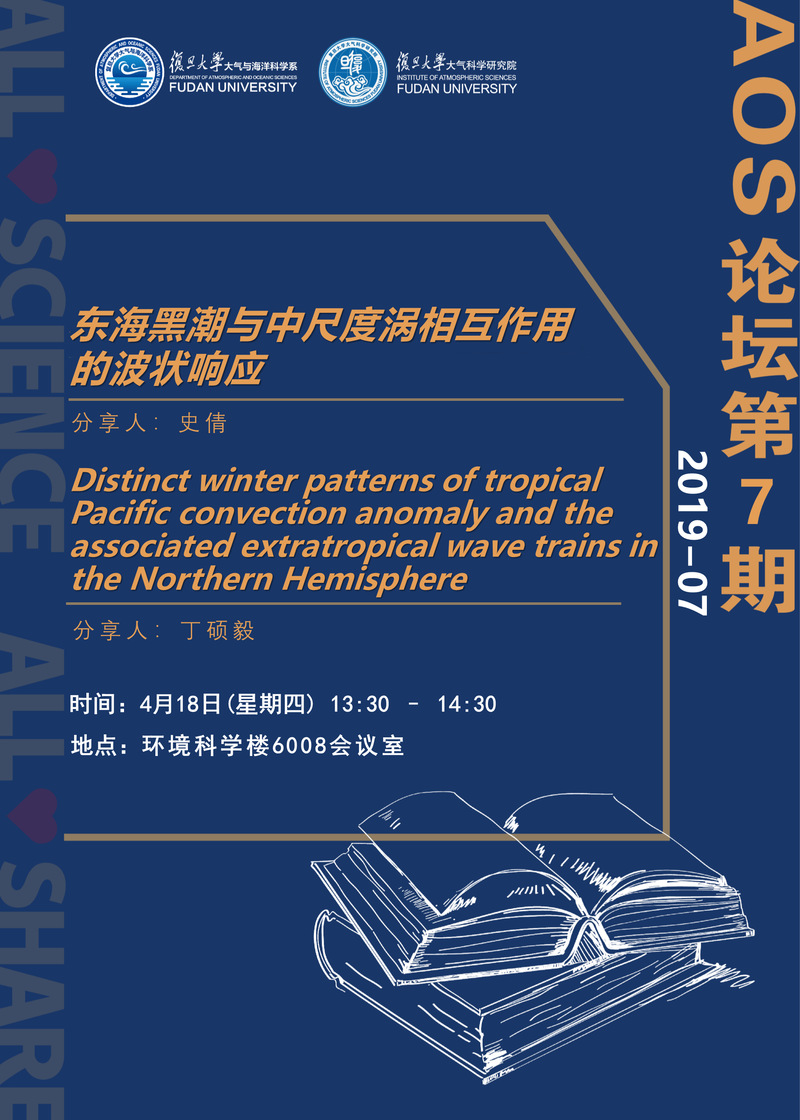
Title: Wavy-path response of the Kuroshio in the East China Sea to the impinging eddies
Qian Shi 史倩
Abstract:Both observation and an idealized model demonstrate that the current path can vary as an eddy impinges on the western boundary current (the Kuroshio). When a strong cyclone/anti-cyclone moves towards the Kuroshio in the East China Sea (ECS), the current axis can be repelled/attracted. The subsequent deviation mainly occurs near the interaction region and spreads to the downstream, forming a dissipated wavelike fluctuation. The spatial-temporal evolution can be explained by an idealized vorticity dynamics model: the magnitude of current path variation is determined by two non-dimensional factors, one is the ratio of eddy strength to the Kuroshio strength, the other is the ratio of horizontal shearing strength in the background to that in the current.
Title:Distinct winter patterns of tropical Pacific convection anomaly and the associated extratropical wave trains in the Northern Hemisphere.
丁硕毅,Shuoyi Ding
Abstract:In this paper, distinct patterns of boreal winter convection anomalies over the tropical Pacific and associated wave trains in the extratropics are addressed. The first leading mode (EOF1) of convection anomalies as measured by outgoing longwave radiation demonstrates an east–west oscillation of deep convection with centers over the equatorial central Pacific (CP) and over the tropical western North Pacific and the Maritime Continent. The second leading mode (EOF2) is also a dipole pattern with opposite centers straddling 170°W, possibly modifying EOF1 to some extent. Combining the first two leading modes, five major categories of tropical convection anomalies can be identified for the period 1979/80-2012/13. The comparison between these five categories and the corresponding SST anomaly patterns indicates a nonlinear relationship between convection and SST. The combination of EOF1 and EOF2 with in-phase PCs exhibits an east–west dipole pattern with opposite signs over west of the dateline and the Maritime Continent. The negative phase of the two PCs, named La Niña pattern, induces a negative Pacific/North American—positive North Atlantic Oscillation teleconnection in the extratropics. Approximately opposite responses can be detected in its positive phase, named CP El Niño pattern. The negative PC2 superposing positive PC1, named EP El Niño pattern, shows the strongest convection anomalies with enhanced (depressed) convection over the eastern (western) Pacific and leads to a Tropical/Northern Hemisphere-like teleconnection pattern and an anomalous anticyclone extending from the North Pacific to the North Atlantic. The positive PC2 with neutral PC1, named western CP pattern, shows weakly enhanced convection to the west of the dateline as a response to local SST warming around the dateline. This convection anomaly pattern, although weak, is important and excites a northeastward wave train from the tropics to Greenland, resulting in surface air temperature cooling covering the northeastern North America and warmer and wetter conditions over Western Europe.